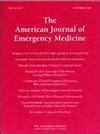院前非创伤成人外周血灌注指数与NEWS评分:一项前瞻性队列研究
IF 2.2
3区 医学
Q1 EMERGENCY MEDICINE
引用次数: 0
摘要
外周灌注指数(PPI)来源于脉搏血氧仪波形,是一种无创且容易获得的参数,反映外周微循环。它在紧急情况下早期识别循环损害和风险分层方面的潜在作用越来越受到关注。尽管其临床相关性越来越大,但研究PPI在急诊非创伤性成年患者的预后价值仍然有限。与此同时,尽管国家早期预警评分(NEWS)被广泛用于预测急性临床恶化,但其在院前环境和未分化患者群体中的有效性仍存在争议。本研究旨在评估PPI对急诊非创伤性成人患者的预后价值。此外,该研究还试图比较PPI与NEWS在确定临床结果(如出院、病房入院、重症监护病房(ICU)入院、24小时和30天死亡率)方面的预测性能。方法本前瞻性观察研究于2025年1月13日至20日在Etlik市医院急诊科进行。包括由救护车到达且PPI可测量的成年患者(≥18岁)。排除创伤病例、心脏骤停、酒精/镇静剂使用、妊娠和资料不完整。入院时记录生命体征、实验室值、PPI(用MASIMO RAD-97测量)和NEWS评分。在1032名救护车入院患者中,452名患者符合纳入标准并进行了分析。结果在2025年1月13日至20日期间,对452例急诊患者进行了PPI和NEWS对患者倾向和死亡率的预测价值评估。与住院组和出院组相比,icu住院患者PPI显著降低,NEWS显著升高(p <;0.001)。多变量分析发现PPI和NEWS是ICU住院的独立预测因子。PPI预测出院(AUC 0.970)和ICU入院(AUC 0.942)的准确性优于NEWS。此外,PPI预测24小时死亡率具有较高的敏感性和特异性(AUC 0.927)。结论sppi是一种快速、无创、可靠的参数,在通过救护车就诊的非创伤成人患者中,与NEWS相比,sppi具有更好的预后效果。PPI有效地预测患者的处置和早期和晚期死亡率,支持其作为早期风险分层和资源分配的有价值的工具。需要进一步的多中心研究来验证这些发现,并建立将PPI纳入临床实践的标准化方案。本文章由计算机程序翻译,如有差异,请以英文原文为准。
Peripheral perfusion index versus NEWS score in prehospital non-trauma adults: A prospective cohort study
Background
The Peripheral Perfusion Index (PPI), derived from pulse oximetry waveforms, is a non-invasive and easily obtainable parameter that reflects peripheral microcirculation. It has gained increasing attention for its potential role in early recognition of circulatory compromise and risk stratification in emergency settings. Despite its growing clinical relevance, studies investigating the prognostic value of PPI in non-traumatic adult patients presenting to the emergency department remain limited. In parallel, although the National Early Warning Score (NEWS) is widely used to predict acute clinical deterioration, its effectiveness in the prehospital setting and in undifferentiated patient populations continues to be debated. This study aimed to evaluate the prognostic value of the PPI in non-traumatic adult patients presenting to the emergency department. Additionally, it sought to compare the predictive performance of PPI with the NEWS in determining clinical outcomes such as discharge, ward admission, intensive care unit (ICU) admission, and 24-h and 30-day mortality.
Methods
This prospective observational study was conducted at Etlik City Hospital Emergency Department from January 13 to 20, 2025. Adult patients (≥18 years) arriving by ambulance with measurable PPI were included. Exclusions were trauma cases, cardiac arrest, alcohol/sedative use, pregnancy, and incomplete data. Vital signs, laboratory values, PPI (measured with MASIMO RAD-97), and NEWS scores were recorded at admission. Out of 1032 ambulance admissions, 452 patients met inclusion criteria and were analyzed.
Results
Between January 13–20, 2025, 452 emergency patients were evaluated for the predictive value of PPI and NEWS regarding patient disposition and mortality. ICU-admitted patients had significantly lower PPI and higher NEWS compared to ward-admitted and discharged groups (p < 0.001). Multivariable analysis identified PPI and NEWS as independent predictors of ICU admission. PPI showed excellent accuracy for predicting discharge (AUC 0.970) and ICU admission (AUC 0.942), outperforming NEWS. Additionally, PPI predicted 24-h mortality with high sensitivity and specificity (AUC 0.927).
Conclusions
PPI is a rapid, non-invasive, and reliable parameter that demonstrates superior prognostic performance compared to the NEWS in non-trauma adult patients presenting to the emergency department via ambulance. PPI effectively predicts patient disposition and early as well as late mortality, supporting its use as a valuable tool for early risk stratification and resource allocation. Further multicenter studies are needed to validate these findings and to establish standardized protocols for PPI integration into clinical practice.
求助全文
通过发布文献求助,成功后即可免费获取论文全文。
去求助
来源期刊
CiteScore
6.00
自引率
5.60%
发文量
730
审稿时长
42 days
期刊介绍:
A distinctive blend of practicality and scholarliness makes the American Journal of Emergency Medicine a key source for information on emergency medical care. Covering all activities concerned with emergency medicine, it is the journal to turn to for information to help increase the ability to understand, recognize and treat emergency conditions. Issues contain clinical articles, case reports, review articles, editorials, international notes, book reviews and more.

 求助内容:
求助内容: 应助结果提醒方式:
应助结果提醒方式:


